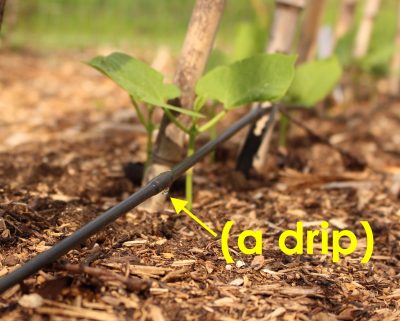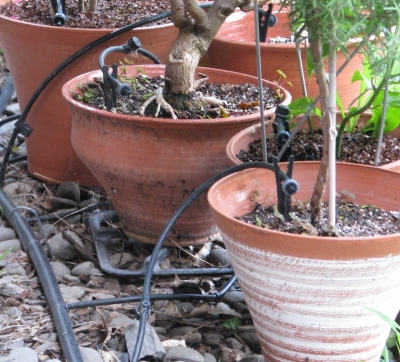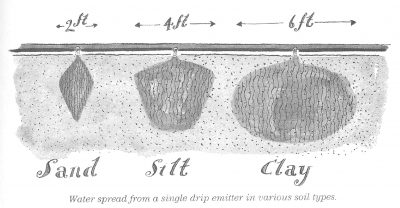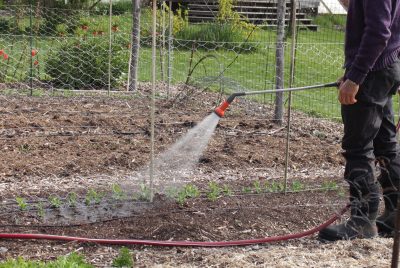DRIP WORK
Many Benefits of Drip
I’m a big fan of drip irrigation, an irrigation system by which water is frequently, but slowly, applied to the soil. It’s better for plants because soil moisture is replenished closer to the rate at which they drink it up. With a sprinkler, soil moisture levels vacillate between feast and famine.
Because of the efficient use of water, drip is also better for the environment, typically using 60 percent less water than sprinkling.

And drip is better for me — and you, if your garden or farmden is dripped. By pinpointing water to garden plants, large spaces between plants stay dry so there’s less weeds for us to pull. And best of all, with an inexpensive timer at the hose spigot, I turn on the system in April and then pretty much forget about watering until the end of the growing season.
Troubleshooting
Today I was reminded about the “pretty much” part of being able to forget about watering until the end of the season. My drip system is set up so that same main line that quenches plant thirst in my two vegetable gardens continues on to water about twenty potted plants. Or not!

I noticed yesterday that some of the potted plants were dry and assumed that the emitters bringing water to these pots were defective. Turns out that sometimes they dripped and sometimes they didn’t. Hmmm. I kept switching around and replacing the “defective” emitters and by the end of the day, for some reason, they were all working. Problem solved.
No! I have a hose connected near my well pump so that I can occasionally hand water some melons I’ve planted in a truckload of leaves a local landscaper provided me with last autumn. Water pressure was very low.
Long story short is that the seasonal line from the well to the pump has a short section of flexible, almost clear plastic tubing. Sun shining on the tubing grew a nice crop of algae within. I disconnected the tube and was able to remove an almost intact tube of algae that had been clogging the line. That was the culprit responsible for the capricious behavior of the drip system and the sluggish behavior of the hose for hand watering.
Thorough cleaning and reconnecting the tubing, wrapping it in aluminum foil to exclude light, priming the pump, and cleaning the sediment filter in the drip line had everything working waterly again. Geez, you gotta be a rocket science to keep things working smoothly. Well, not quite.
I’ve now marked my calendar to check the drip system every 3 weeks.
Some Attention Necessary
In addition to checking periodically to make sure that the water flows unobstructed, my watering system — any drip system — requires other regular attention, including a small amount of hand watering. The reason has to do with the shape of the wetting front drip presents in the soil. As a drip of water enters the ground, gravity pulls water downward at the same time that capillary action is pulling the water horizontally. Down in the ground, that wetting front is shaped like an ice cream cone, at first widening with depth and then narrowing to a point.
The width of the cone depends on soil porosity. Clay soils have small particles with commensurately small pores (illustration from my book Weedless Gardening).

Those small pores exert a strong capillary pull so the ice cream cone spreads wide, as much a six feet at its widest down from each point source of water. At the other extreme is a sandy soil, whose large particles have large spaces between them and comparatively little capillary pull; the result is a slender ice cream cone, spreading no more that a couple of feet wide.
A drip system is a series of emitters, so the wetting fronts can merge together at their widest points presenting a wetting front that in soil cross section looks like waves below ground, with peaks at ground level at each emitter. (This illustration is also from Weedless Gardening.)

Distance between peaks depends on the spacing of drip emitters. Depth of the wave troughs between the peaks depends on the soil texture and emitter spacing. A soil rich in clay with close emitter spacing would be wet at the peaks, with the “waves” relatively close to the ground surface between the peaks.
Between emitter peaks, the ground is dry near the surface. Plant a seed there and, in the absence of rain, the seed will just sit. Tuck a transplant into the soil there and, in the absence of rain, it will dry out and die. Hand watering gets that seed or transplant’s roots growing; once the roots reach down far enough to tap into the wetting front, they’re on their own.

To avoid hand watering I sometimes move the drip line right over the row where I planted seeds or right along the row where I set transplants. After a few days or once seeds sprout, I move the drip line back to its rightful position which, along with one other line, is about 9 inches in from each of the outer edges of my 3 foot wide vegetable beds.
Only one more maintenance item for my drip system. If it has rained cats and dogs, that is, more than 1 inch, as measured in a rain gauge, I might turn off the drip system temporarily. Then — and this is very important — I’ll stick a Post-It note on which is written “Drip” to my bathroom mirror as a reminder to turn the drip system back on in due time. Drip irrigation is low maintenance, but not no maintenance.


How long do you run your drip system for?
Total of about 1/2 hour per day.
Great piece, particularly discussing differing soils. What I am curious about is the gpm rates for the Vegies. One gallon per hour, Two, one-half? That’s confusing, do you have a chart that shows a rough guide?
Definitely worth further discussion
I always use 1/2 gallon per hour emitters. For watering beds, I buy emitter lines with close spacing although in a soil high in clay, wider spacings could be used.
Lee, I just discovered you and your website after hearing you on Margaret Roach’s podcast, and I am thrilled! We have had an organic vegetable garden for years, but I’m just now learning about and preparing to install a drip irrigation system. You said that you buy emitter lines with “close spacing” – is that 6″, 9″, 12″? And can you explain your choice of spacing? We have medium soil with lots of organic matter, and have just started the no-till method this year.
DripWorks sells kits that come with 12″ spacing, but if that isn’t best I would buy different drip line.
The more quickly draining the soil — a sand, for instance — the more call for closer spacing. An emitter’s wetting front makes a more or less ice ream cone shaped volume in the soil, a more slimmer one the quicker the soil drains. A closer spacing makes for more overlap of wetting fronts and more wetter soil close to ground level.
Thank you Lee. I just bought your book “Weedless Gardening”, and it explains everything!
Good info on drip!
What would the affect of mostly clay soil with large rocks have? I’m thinking the soil above the rock would dry quickly and the clay would stay wet longer making watering effectively especially daunting. Curious on your take.
What brand of watering wand is that? I have liked and typically use Dramm for large volumes with gentle watering but the wand you are using doesn’t look like a Dramm. It seems to have a similar pattern.
Also, specific brand of drip tubing and emitters you have been pleased with?
Thanks as always!
For that clay situation, probably best with longer intervals between watering.
That water wand I am using was from Gardena. My water pressure doesn’t seem high enough to use Dramm wands effectively. I get my drip supplies from http://www.dripworks.com, but most sellers don’t make their own components so yu can get the same components from many sources.
Your comments on drip irrigation are very interesting and I want to share with you my adventure in irrigation, which arose out of my attending one of your workshops. I took your advice and went to drip works to get a complete system. Timer, pressure regulator, water filter, half-inch hoses, emitters, hole punch, etc.
I installed it and just assumed that everything would be fine. It wasn’t. I noticed that some of the emitters, on the downhill side of the garden were emitting just swell, but the other emitters, on the uphill side weren’t. I called the emitter company and they asked me engineering questions! I hadn’t realized that this was an engineering project, but it sure is. It turned out that the number of emitters I had were emitting a lot more water than my well was producing. The solution was to split the system in half, adding another timer and running half of my emitters off of one timer at half off the other. Problem solved. Who knew one had to be an engineer to have a garden?
If you think it would be helpful to your readers, please feel free to share this. And thanks for all the work you do and for helping me with my garden.
Basically, you should compute the rate of water use via all your emitters, and then make sure your water supply can deliver at that rate. Or split the system, as you have done. You also have to size the mainlines according to the rate of water use. And finally, for illy areas or long runs, emitters need to be pressure compensating.
Lee, I took your class on drip that you held at Margaret Roach’s garden. My drip system is in and works beautifully. One question I am curious about is the timing you have on your garden. I got the LinkTap timer which I love and it skips days before or after 0.25 inches of rain. I had it set to drip one hour a day in mornings but have cut it back to 30 minutes. I know emitter spacing and soil are factors, and I am in raised beds, but what are your timers set at as a comparison? Thanks.
I water for about 30 minutes pre day, spread out over as many daylight hours as the timer is capable of. E.g. Three times a day for 10 minutes per, or twice a day for 15 minutes per, etc. That’s pretty good to be able to skip watering after .25 inches of rain. Is there a specific model of LinkTap that does this?
LinkTap Wireless Water Timer & Gateway, Cloud Controlled Smart Hose Faucet Timer, Greater Wireless Coverage Than Wi-Fi, 2 Years Battery Life, Quick 2 https://www.amazon.com/dp/B07BKZ3YZY/ref=cm_sw_r_cp_apip_G4bEUIZqjjw5f
Thanks. I’m going to check it out.
Excellent and interesting article. My garden is small with a wide range of plants with different water and soil needs, so I basically spot water as needed. I grow rare plants from seed as a hobby. In my veggie plot (almost pure sand) I buried straw bales to compensate for the time I will need to build up organic matter which appears to disappear into an invisible vortex faster than I can apply, scrounge, or afford it. I am considering the drip system. Thank-you
Lee, I’m laying newspaper and mulch this week to contain an outbreak of weeds. I have drip lines in my beds. Do I lay newspaper, driplines, and then mulch? Or driplines, newspaper, mulch?
Newspaper, mulch, driplines. The lines could be buried but I like them on the surface where I can periodically check up on them.
How helpful that you talk about how if it is raining a lot it is best to turn off the drip system temporarily. I am thinking of starting a garden this summer. I will also find a great drip sprinkler installation company locally.